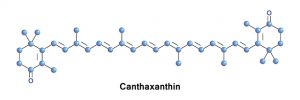
Canthaxanthin sources, health benefits and uses
Tuesday, September 12, 2017 by Jhoanna Robinson
http://www.naturalpedia.com/canthaxanthin-sources-health-benefits-and-uses.html

Canthaxanthin, a phytochemical of the common yellow pigment in the class of Xantophylls belonging to the group of Carotenoids (tetraterpenoids), is identified as a coloring agent and has been approved by the United States Food and Drug Administration (FDA) as a food additive. It is akin to the chemical that gives carrots the color orange. It can deposit in the skin to serve as an artificial tan.
Canthaxanthin naturally occurs, but it can also be manufactured inside a laboratory. It has found its uses in the world of medicine.
Scientists first found the presence of canthaxanthin in edible chanterelle mushrooms. Canthaxanthin can also be obtained by eating carp, crustaceans, green algae, golden mullet, paprika, and Pacific salmon.
People who have allergies to vitamin A or carotenoids should take care not to accidentally ingest products that have canthaxanthin. Pregnant women and lactating mothers are also advised against ingesting canthaxanthin, for there has yet to be literature that would detail the carotenoid’s effects on an unborn fetus or a young infant.
Some side effects of taking canthaxanthin pills include incurring aplastic anemia, a possibly fatal condition in which the bone marrow fails to make new blood cells. In 1989, it was discovered that taking canthaxanthin pills causes the reversible deposition of yellow crystals in the retina of the eye, and thereby decreasing the ability of light-sensitive cells to see light at lower levels.
High doses of canthaxanthn can also cause diarrhea, dry and itchy skin, hives, nausea, orange or red body secretions, and stomach cramps, among others.
Also, the FDA issued a warning in 2003 to all companies that marketed products that contained canthaxanthin that it may cause liver toxicity, and said that the companies should take into consideration the memo when manufacturing more products that contained the carotenoid.
Medicinal uses for canthaxanthin
Canthaxanthin has antioxidant properties. As such, it can protect people against the harmful rays of the sun, and therefore prevent skin diseases.
Canthaxanthin, which is also called orobronze, is commerically distributed in Canada as a nonprescription “tanning pill”. It has yet to find FDA approval in the United States as a tanning pill; however, canthaxanthin as a tanning pill has been available to Americans for a long time now via tanning salons and mail order.
Canthaxanthin has been said to have the ability to address rashes due to sun sensitivity or polymorphous light eruptions. For best results, canthaxanthin and beta-carotene should be taken orally.
Canthaxanthin also helps to treat vitiligo, a long-term skin condition that is characterized by pale white patches developing on the skin. For best results, a person diagnosed with vitiligo should take a specific product, Carotinoid-N (which contains beta-carotene and canthaxanthin), to slightly clear his skin sores and to protect him in the sun.
Body systems supported by canthaxanthin
Canthaxanthin has been found to be good for oral health. In a study titled “Chemoprevention of rat oral carcinogenesis of naturally occurring xanthophylls as astaxanthin and canthaxanthin” that was conducted by Japanese scientists, it was found out that the carotenoids astaxanthin and canthaxanthin can prevent the occurrence of oral cancers.
Canthaxanthin has proven to address abdominal obesity. In a recent study, it was found that people with a high waist circumference considerably lack canthaxanthin levels ion their body.
Where to learn more
- Study shows reishi mushrooms benefit people stricken with a variety of ailments, from high blood pressure to AIDS
- Golden rice exposed as fraud: Genetically engineered crop nothing more than biotech battering ram to crush GMO regulations
- Spirulina shown to prevent and treat cancers while boosting immune system function
- Nutrients.news
Summary
Canthaxanthin has antioxidant properties.
Canthaxanthin, which is also called orobronze, is commerically distributed in Canada as a nonprescription tanning pill.
Canthaxanthin has been said to have the ability to address rashes due to sun sensitivity or polymorphous light eruptions.
Sources include:
Tagged Under: Tags: canthaxanthin






